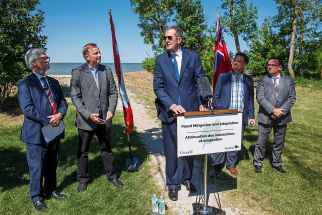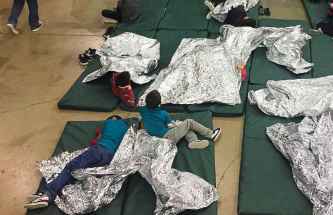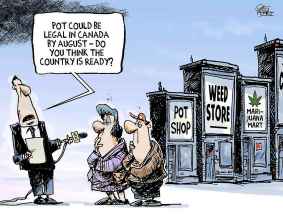Churchill area worst in Canada for child poverty
Read this article for free:
or
Already have an account? Log in here »
To continue reading, please subscribe:
Monthly Digital Subscription
$0 for the first 4 weeks*
- Enjoy unlimited reading on winnipegfreepress.com
- Read the E-Edition, our digital replica newspaper
- Access News Break, our award-winning app
- Play interactive puzzles
*No charge for 4 weeks then price increases to the regular rate of $19.00 plus GST every four weeks. Offer available to new and qualified returning subscribers only. Cancel any time.
Monthly Digital Subscription
$4.75/week*
- Enjoy unlimited reading on winnipegfreepress.com
- Read the E-Edition, our digital replica newspaper
- Access News Break, our award-winning app
- Play interactive puzzles
*Billed as $19 plus GST every four weeks. Cancel any time.
To continue reading, please subscribe:
Add Free Press access to your Brandon Sun subscription for only an additional
$1 for the first 4 weeks*
*Your next subscription payment will increase by $1.00 and you will be charged $16.99 plus GST for four weeks. After four weeks, your payment will increase to $23.99 plus GST every four weeks.
Read unlimited articles for free today:
or
Already have an account? Log in here »
Hey there, time traveller!
This article was published 18/06/2018 (2736 days ago), so information in it may no longer be current.
The state of child poverty in Canada appears dire, according to a report released Monday by Campaign 2000, a national advocacy group. But in no federal riding is the situation worse than in the northern Manitoba riding of Churchill-Keewatinook Aski, where nearly two thirds of children live in poverty.
The report analyzed the number of Canadian children living in poverty — more than 1.2 million — and calculated the child poverty rate in each federal riding. Three Manitoba ridings placed in the top 10, including Winnipeg Centre (ranked third, 41.1 per cent) and Dauphin-Swan River-Neepawa (ranked ninth, 33.8 per cent). But at a rate of 64.2 per cent, Churchill has the highest rate of child poverty among all federal ridings by nearly 10 percentage points.
Campaign 2000 uses census data and a standard called low-income measure after-tax data to determine which families live in poverty. For example, a couple with one child would be characterized as living in poverty if they made less than $30,962 after taxes.
"It is unconscionable that child poverty is more the norm than the exception [there]," the report says.
"This didn’t just happen," said Niki Ashton, the MP for Churchill, which is largely populated by Indigenous peoples. "It is the result of the history of colonization and continued chronic federal underfunding of housing, of health care, of education, of infrastructure more broadly."

By no means is child poverty restricted to one region, the report shows. Of 338 ridings, 162 have child poverty rates higher than the national average, which sits at 17.4 per cent. Of the Manitoban federal ridings, only five fell below that mark. And as of 2015, Manitoba had the highest rate of any province at 27.5 per cent, with 81,970 children living in poverty according to Campaign 2000’s fall report.
Many of the ridings with the highest incidence of child poverty also feature higher-than-average proportions of visible minorities and racialized people. Nearly two-fifths of Indigenous children live in poverty, and about the same percentage of people living in the ridings in the highest quintile are visible minorities, as opposed to 14 per cent in the wealthier ridings.
"Child poverty has an emotional, mental and spiritual impact on our youngest citizens, our future generations," MKO Grand Chief Sheila North said. "And this isn’t just a First Nation issue, we see families among our Canadian neighbours who also struggle with the lack of services, supports, and infrastructure in northern Manitoba."
"I think it’s terrible," said Winnipeg Centre MP Robert-Falcon Ouellette of his riding’s ranking and of the over-representation of Indigenous and racialized people below the poverty line. "I don’t think anyone is surprised," he added. "I think we have a large Indigenous population which has been ignored in pretty well every area you can imagine for over a century."
"Hopefully [the report] lights a fire under the seats of the decision makers," he said.
!function(e,t,n,s){var i=”InfogramEmbeds”,o=e.getElementsByTagName(t)[0],d=/^http:/.test(e.location)?”http:”:”https:”;if(/^/{2}/.test(s)&&(s=d+s),window[i]&&window[i].initialized)window[i].process&&window[i].process();else if(!e.getElementById(n)){var a=e.createElement(t);a.async=1,a.id=n,a.src=s,o.parentNode.insertBefore(a,o)}}(document,”script”,”infogram-async”,”https://e.infogram.com/js/dist/embed-loader-min.js”);
Scott Fielding, Manitoba’s families minister, questioned the accuracy of the data the Campaign 2000 report relied on, saying the low-income after tax figures didn’t account for cost of living differences between provinces and territories. "More recent data sources, such as the 2016 Canadian Income Survey and Mass Basket Measure show Manitoba is no longer Canada’s ‘child poverty capital,’" he wrote to the Free Press.
Sid Frankel, an associate professor of social work at the University of Manitoba and a member of Campaign 2000’s steering committee, called the low-income measure "the international gold standard," and said it’s used by both UNICEF and the Organization for Economic Co-operation. He called the basket measure and income survey preferred by Fielding an inadequate measure of poverty that excludes those on reserves and Aboriginal settlements.
"This is a fatal flaw because Aboriginal people have very high rates of poverty," he added.
Campaign 2000 began in 1989 when the House of Commons unanimously resolved to end child poverty in Canada by the start of the new millennium. But while several provinces have seen significant decreases in the nearly three decades since, Manitoba’s rate of child poverty has jumped by about 20 per cent.

The organization is pushing for the prioritization of child poverty prevention, reduction and eradication ahead of the upcoming federal poverty reduction strategy. Ultimately, the group believes the government can reduce child and family poverty by half by 2020 and, by 2022, reduce the amount of households experiencing food insecurity by 50 per cent, among other goals which the report calls "bold but achievable."
Recommendations include: increasing the base amount of the tax-free Canada Child Benefit, which provides $6,400 per child under the age of six and $5,400 per child between six and 17 years old on an annual basis to eligible families; applying employment equity criteria jobs created through federal infrastructure investments in order to curb discrimination against racialized people; and a "dignity dividend" of $1,800 per person living below the poverty line, which the Canadian Centre for Policy Alternatives projects to "lift 560,000 people out of poverty–half of whom are children."
Kate Kehler, the executive director of the Social Planning Council of Winnipeg, said her organization and other local groups participated in consultation ahead of the federal and provincial strategy announcements. She said she’s optimistic about the strategy treating each communities’ needs as unique, and not through a "cookie-cutter" approach.
!function(e,t,n,s){var i=”InfogramEmbeds”,o=e.getElementsByTagName(t)[0],d=/^http:/.test(e.location)?”http:”:”https:”;if(/^/{2}/.test(s)&&(s=d+s),window[i]&&window[i].initialized)window[i].process&&window[i].process();else if(!e.getElementById(n)){var a=e.createElement(t);a.async=1,a.id=n,a.src=s,o.parentNode.insertBefore(a,o)}}(document,”script”,”infogram-async”,”https://e.infogram.com/js/dist/embed-loader-min.js”);
Earlier in June, the Winnipeg Street Census was released and tallied 1,500 people experiencing homelessness in the city, many of whom were youth or became homeless before the age of 18. Kehler hopes the census and the poverty report will lead to swift action by all levels of government.
Fielding pointed to the increase of the basic personal amount and an expansion of rent assist and child care funding as moves the provincial government has already made to address child poverty, but Frankel disputes their efficacy. "Increasing the basic personal amount does little for the poor because the benefits are spread to all taxpayers," he said. "Moving from social assistance to a job is not necessarily a movement out of poverty," he added.
"It doesn’t take boutique responses," Ashton told reporters in Ottawa. "What we need is to address the underfunding more broadly and we need federal leadership. This is a question of priorities. Instead of investing in a $4.5-billion pipeline and running roughshod over First Nations rights, why isn’t the government addressing the chronic underfunding and the legacy of colonialism that’s so evident in abject child poverty?"
The federal government has promised to put out their poverty-reduction strategy before the October 2019 election, and advocates expect it to come this fall, alongside the federal plan for Indigenous housing.
– with files from Dylan Robertson
bwaldman@freepress.mb.ca
Twitter: @benjwaldman


Ben Waldman covers a little bit of everything for the Free Press.
Our newsroom depends on a growing audience of readers to power our journalism. If you are not a paid reader, please consider becoming a subscriber.
Our newsroom depends on its audience of readers to power our journalism. Thank you for your support.








